Korfball drills
Setup:
Which team brings in most gold pieces/ pits?
Which team brings in most gold pieces/ pits?
- 1 bank & one-against-all
- 2-4 gangs of thieves
- 1-2 guards.
Game consists of 4 rounds of play:
Game Round 1:
Game Round 1:
- Thief - attacker: per post only 1 active & 1 gold piece at a time try to steal from bank.
- Collect in own vault -hoop-.
- Guard - defender- may only defend outside the bank.
- If the thief is caught so tapped, he must leave the gold piece in the police station -under a cone.
- Which team was able to steal most gold pieces?
Game Round 2:
- Divide gold pieces equally among the thieves.
- Thieves: safely move your gold pieces 1-for-1 to other safe -from one hoop to another.
- Thief -attacker: walk around your cone without the guard catching you.
- Agent -defender: in this case may only defend inside the bank.
- If the thief is caught -attacked, he must leave the gold piece in the police station -under a cone.
- Which team was able to transfer most gold pieces safely?
Game Round 3:
- Thieves: for x time, steal as many gold pieces as possible from other safe.
- Thief -attacker: mandatory back & forth through bank = watch for guard inside bank.
- Guard may only defend inside bank.
- If the thief is caught so tapped, he must leave the gold piece in the police station -under a cone.
Game round 4:
Same as game round 3, but with double guard 1 guard outside & 1 guard inside the bank.
Which team will have the most gold pieces in their possession after 4 rounds of play?
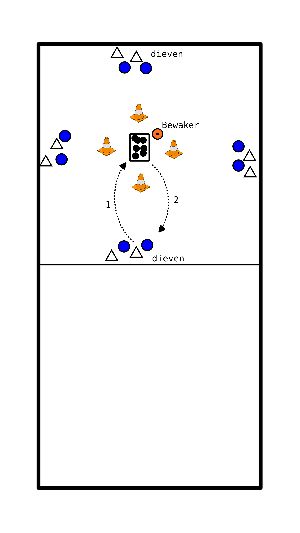
Setup:
X number of baskets.
Variant 1:
Have the little players use the dice to determine how many shots/chances to score at each basket.
They may dribble with the ball to the other basket.
Variant 2:
Different types of chances.
With 1 hand, penalty throw, through ball while running with the ball.
X number of baskets.
Variant 1:
Have the little players use the dice to determine how many shots/chances to score at each basket.
They may dribble with the ball to the other basket.
Variant 2:
Different types of chances.
With 1 hand, penalty throw, through ball while running with the ball.
Setup:
- 1 basket in oval, with a basket directly opposite at 8 meters.
- 1 Player in front of the basket with ball.
- 2 Players behind the basket just outside the oval.
- During the exercise pay attention to shooting technique.
- The others wait at the side - maximum 3 players.
Variation 1:
- Player 1 takes shot.
- Players behind the basket take running Rebound.
- The Player who has the Rebound becomes shooter.
- The Player who lost the Rebound duel now enters the rebound duel with the next player from the queue.
- The shooter joins the queue.
Variant 2:
- Same as Variation 1, but the Player who has the Rebound takes a short chance.
Variant 3:
- Same as Variation 1, but the Rebounders now try to score a goal in the basket opposite. The Shooter becomes a defender.
Variant 4:
- Same as Variant 3, but with maximum 1 or 2 passes towards the basket opposite.
Attacker uses feints to get past the defender.
- There are 6 players between the pawns.
- There must be 1 hole per row of pawns.
- The other players try to use feints to find the hole.
- The defenders may only defend widthwise and try to tap the attackers.
- If you get tapped, you have to start over.
- If the attackers reach the other side, they get 1 point.
- After 5 points, the game is switched.
- The game can be made easier by adding fewer defenders.
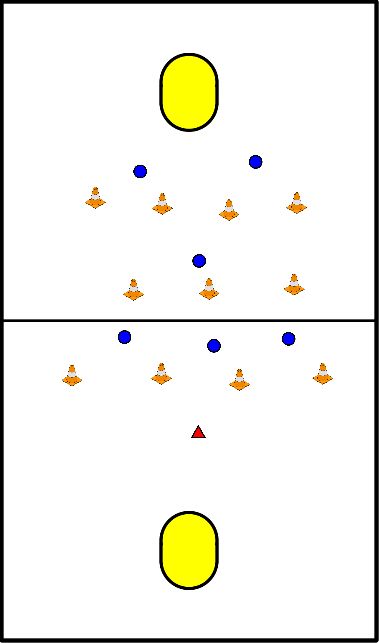
- 6 players at the pawns, 1 in front.
- The one in front of the pawns tries to find a hole to get through by feints.
- Defender may only move left right.
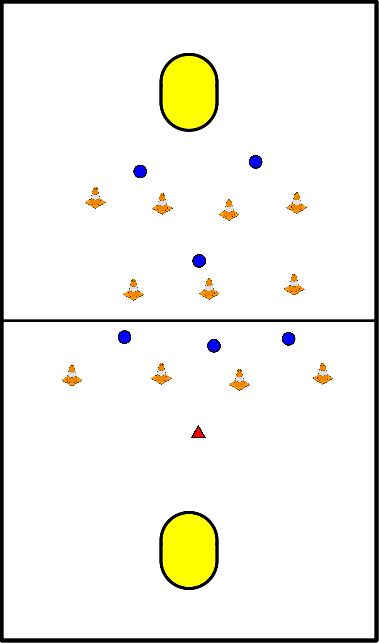
- You are going to throw up from 2 meters distance
- If you get it right 10 times, step back to a certain point
- Then you go back and throw on 1 leg
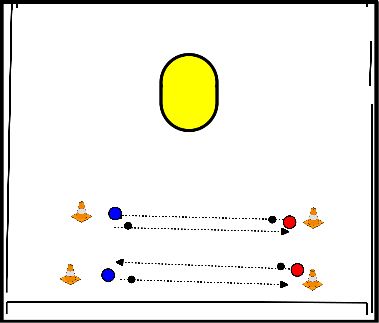
Objective:
The base is a standard running form exercise, where you have players move back and forth in different ways to train general motor skills.
The tap game element adds responsiveness by having players react as quickly as possible and determine what they are going to do.
The tap game element adds responsiveness by having players react as quickly as possible and determine what they are going to do.
Description:
- The players stand on a line and are given a way by the trainer to run across each time, see also running forms.
- All players have a ribbon on, 1-3 players with the same color.
Occasionally, while walking back and forth, the trainer calls out the color of 1 of the ribbons. These then become the tickers. The tickers get 10 seconds to tap as many of the remaining players as possible. - Then all return to the same line and start a running form again.
- The idea is to start the tagging round immediately when the trainer calls a color and to quickly start the next running form when the tagging round is over. Keep up the pace.
Variations:
Instead of running forms where players walk back and forth, you can do movement exercises standing in the same spot. Examples include Jumping Jacks, sitting/lying and getting up again, jumping forward and backward, etc.
The trainer occasionally gives the next movement assignment and calls a color to start a tap round.
Running Forms:
Standard
- Running / Running backwards
- Hopping / Hopping backwards
- Sideways with front right / Sideways with front left
- Small steps
- Hopping on right / Hopping on left
- Cross pass
Jumps
- Jumps as large as possible.
- Medium-sized jumps and always balancing on 1 foot for a while before taking the next jump.
- With two feet side by side.
- With two feet side by side a big jump forward and another small jump back.
- With two feet zigzagging.
Arm movements to be combined with the above forms.
- Swing 1 arm forward or backward.
- Swing both arms forward, or both backward.
- 1 arm forward and 1 arm backward.
- Holding another body part with 1 or both arms.
As animals
- Frog; jumping on hands and feet.
- Crab; on hands and feet, with belly up.
- Kangaroo; jumping on two legs.
- Flamingo; hopping.
- Duck; crouching walk.
The trainer occasionally gives the next movement assignment and calls a color to start a tap round.
Running Forms:
Standard
- Running / Running backwards
- Hopping / Hopping backwards
- Sideways with front right / Sideways with front left
- Small steps
- Hopping on right / Hopping on left
- Cross pass
Jumps
- Jumps as large as possible.
- Medium-sized jumps and always balancing on 1 foot for a while before taking the next jump.
- With two feet side by side.
- With two feet side by side a big jump forward and another small jump back.
- With two feet zigzagging.
Arm movements to be combined with the above forms.
- Swing 1 arm forward or backward.
- Swing both arms forward, or both backward.
- 1 arm forward and 1 arm backward.
- Holding another body part with 1 or both arms.
As animals
- Frog; jumping on hands and feet.
- Crab; on hands and feet, with belly up.
- Kangaroo; jumping on two legs.
- Flamingo; hopping.
- Duck; crouching walk.
- Each player gets his own pipsack.
- They are told an action by the trainer, which they perform.
- This can be touching your head, sitting down and standing up quickly, etcetera.
- As soon as Yes is called (or another action word), the piping bag can be taken.
- Bottle football only throwing.
- For each player there is one bottle filled with water.
- You choose a teammate against whom you want to play and so put the two bottles opposite each other with a few meters distance. (The further apart they are, the more difficult).
- You try to knock over your opponent's bottle.
- If you succeed, your opponent must first take the ball and only then can you put the bottle back up.
- You win if your opponent's bottle is empty.
- Try to bounce through 'the forest' without the 'trees' knocking the ball away with their 'branches', then score in the baskets behind the forest.
- Who has scored the most goals?
- Step 1:
- You may occasionally grip the ball with two hands.
- Step 2:
- You may occasionally bounce the ball with 2 hands.
- Step 3:
- You must do everything with one hand.
Rules:
- A runner may not hold the ball in 2 hands, but must bounce with 1 hand.
- A runner must stay within the lines or the forest.
- If the ball is tapped away from the runner, the runner will start over again.
- Make sure the children don't have to wait.
- Several runners start at the same time!
- If the runner manages to get out of the forest, the runner can:
- Step 1:
- Shoot at the cor until a score is scored.
- Step 2:
- Max. 1 shot.
- The 'tree' stays completely in the hoop or with one leg.
- Choice of the trainer.
- The 'tree' can tap the ball away with 2 hands or with one hand on the back.
- Choice of the trainer.
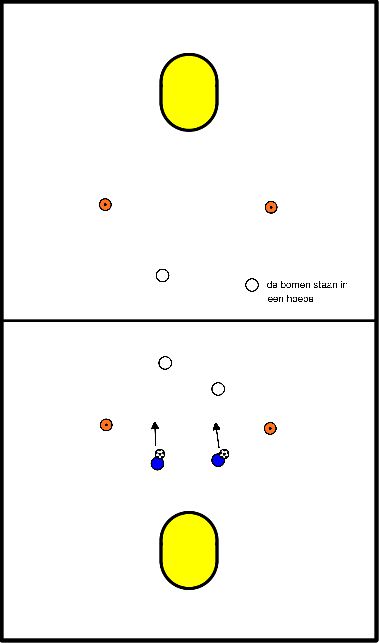
Step 1:
- As a hunter duo, try to move yourself around the field, playing over and throwing off as many runners as possible within 1 minute.
Step 2:
- Try to take the ball away from the hunters as quickly as possible, play over and score in the basket, but be careful not to get tapped by the hunters.
- This is allowed when you have the ball in your hands.
Rules:
- Lay the hats down in a square with approx 5m between the hats.
- Two players are the tappers, the rest move inside the square.
- The two scapegoats are allowed to scapegoat the other players with the ball. The catchers are not allowed to walk with the ball.
- By throwing over the ball the taggers can tap the other players.
- If you are tagged or left outside the box, you are out and you can join again if you have scored a goal.
- At step 1 the runners are not allowed to touch the ball of the hunters.
Variation:
- When players are out, they belong to the tag team instead of being out of the box.
- This is only allowed after they have scored.
- More or less players and therefore more or less balls.
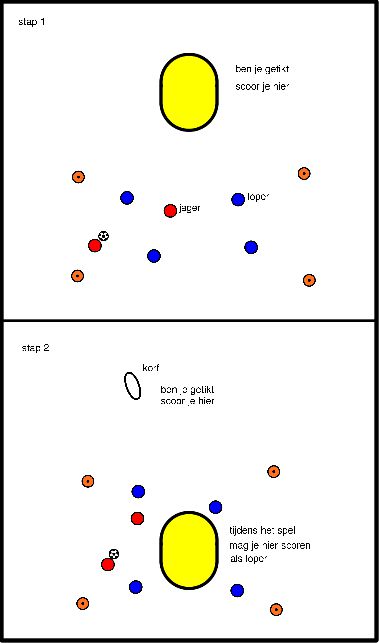
Task:
- Who is the first to circle the ball or the player?
Rules:
- Everyone stands in a circle with enough space to throw a ball quickly.
- The ball starts to the right of the child who is going to run.
- The child who is going to run, runs at the same time as throwing the first ball on the outside of the circle.







